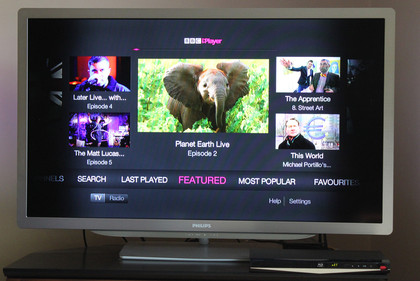Why you can trust TechRadar
After a lengthy firmware upgrade process of about 10 minutes, we're ready to explore the Toshiba BDX3300's incredibly rudimentary user interface. It's actually quite an achievement to get smart TV services onto a box that just doesn't seem set up for such a dimension, but in practice such streaming services work well.
We're full of fear at first, with the home screen looking like something from a mid-1990s PC monitor. A basic settings menu is joined by a connection test and the usual tweaks and information, but in truth it's the bare bones presentation rather than the functionality that worries us.

A 'front-end update' then kicked in during our test, but didn't change anything.
The key interface, which is slightly separate from the main Setup screens, is called Media Center - accessed via the 'MC' button on the small remote. A basic list of sources is then presented, with USB (if connected) above BDMV (or whatever disc is in the tray), Connection and Media Server Search. Those last two are worth exploring.

The oddly named Connection link leads to a list of smart TV services: BBC iPlayer, Acetrax, YouTube and Picasa in the UK and Netflix, VUDU and YouTube in the US. The BBC iPlayer browser - the usual interface that will be familiar to any Brit who's used almost any brand of smart TV - loads quickly and is as stunningly useful as ever.
That's probably enough to convince any wavering potential buyer, although if we were being fussy it would be nice to have a shortcut on the remote for the iPlayer, to avoid time spent in those clunky menus.

YouTube on the Toshiba BDX3300 consists of new (to us) software that divides videos by genre, while both the Picasa and Acetrax apps are the standard, polished-looking versions as seen on far pricier platforms.
Media Server Search links with other DLNA-compatible gear, in this case a Samsung netbook running Windows 8 Consumer Preview.

In our test we managed to play JPEG photos and MP3 music, and in a shock revelation we also managed to play AVI and MP4 video files. Now that's something we didn't think would be on offer.
Just as surprisingly, we also managed to play some video files from a docked USB flash drive. AVC HD, AVI, MP4 and MPEG files all played without problems, complete with scan navigation controls, but MKV and MOV files weren't recognised.

Even more of a surprise was the Toshiba BDX3300's support of lossless FLAC audio files, as well as the usual MP3 support (protected M4A files are also played), although photographs are limited to JPEG, with which the Toshiba BDX3300 performs a decent slideshow.
All of this to and fro-ing between menus can sometimes be slow and a tad long-winded, which isn't helped by a remote control that's simply too small and crowded. But in terms of core functionality, we've got no complaints.
Picture quality
Colourful, bright and precise, the images delivered to our test screen from the Toshiba BDX3300 have plenty of finesse in contrast to its on-screen menus.

From our test disc Grand Canyon Adventure, the Toshiba BDX3300 delivers scene after scene of stunning visuals; a night-time camping scene sees a pin-sharp shot of a campfire illuminated against a completely black background, while another sequence of white water rafting is presented with plenty of detail of depth.
Slow panning shots around the canyon walls do reveal a smidgen of judder, but it's slight. Colours, too, could be pulled up for being a touch over-saturated (something's that's evident in skin tones), but this is something that for the most part works in the Toshiba BDX3300's favour. Again, for the money it's a cracking performance.
Jamie is a freelance tech, travel and space journalist based in the UK. He’s been writing regularly for Techradar since it was launched in 2008 and also writes regularly for Forbes, The Telegraph, the South China Morning Post, Sky & Telescope and the Sky At Night magazine as well as other Future titles T3, Digital Camera World, All About Space and Space.com. He also edits two of his own websites, TravGear.com and WhenIsTheNextEclipse.com that reflect his obsession with travel gear and solar eclipse travel. He is the author of A Stargazing Program For Beginners (Springer, 2015),

